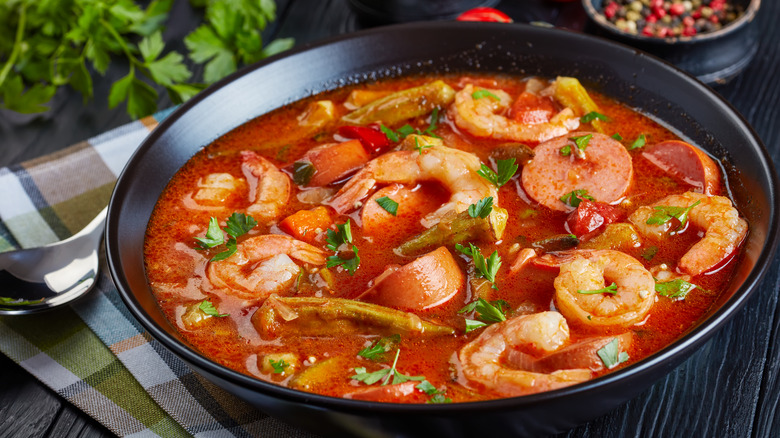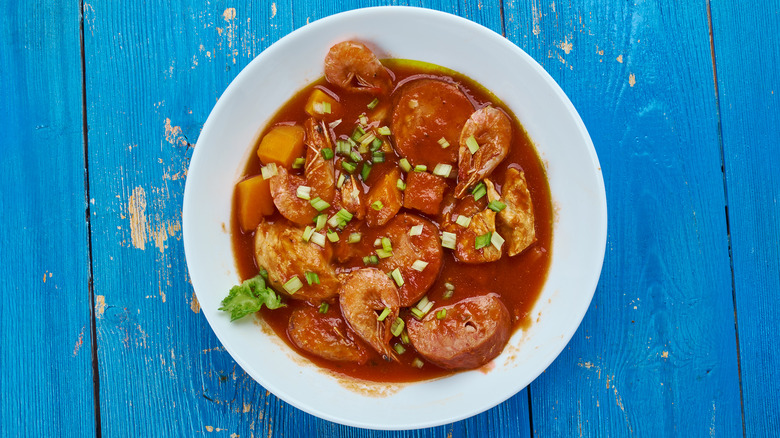What's Really In Gumbo?
If you're new to Cajun or Creole cuisine, it can feel intimidating, especially when someone plops down a bowl of something called gumbo. The thick stew, which is native to Louisiana and the American South, evolved from the culinary traditions of indigenous Native American communities, West African tribes, and European influence, particularly those of rural France (via Serious Eats). It's further differentiated based on whether it's a Cajun or Creole version of the dish, explains Southern Living.
Even if you've eaten gumbo a hundred times, there's no guarantee it will taste the same. That's because each cook has their own version of what makes the best gumbo, and they aren't necessarily going to tell you what is in that bowl. However, there are a few crucial things pretty much universal to genuine Louisiana-style gumbo, including bell pepper, onion, and celery, which is also known as the "Holy Trinity" (via Louisiana Travel). Whether you're making seafood, chicken, sausage, or vegetarian gumbo, don't skip these must-have components.
What's in that steaming pot of Cajun gumbo?
Here is the simplest answer as to what is really in gumbo: It contains some form of meat or seafood, okra, ground sassafras leaves, roux, and the trio of Holy Trinity vegetables, according to Kitchn. Many family kitchens have hosted arguments over what makes the perfect gumbo, but the Cajun-style undisputedly starts by making a thick brown roux with a rich gravy-like consistency. In an interview with Cleveland Magazine, Chef Johnny Schulze from Bourbon Street Barrel Room recommends making Cajun rue with a fat and flour combined with a small amount of broth, then toasting it in a pan until it reaches that chocolate-brown hue.
Andouille sausage stakes a claim in most Cajun gumbos, imparting a smoky flavor with a cayenne pepper kick. It's often mixed with shrimp and sometimes chicken. Schulze reminds home chefs that, other than the Holy Trinity, okra is one of the only other vegetables in Cajun-style gumbo and that it is a crucial component to the final dish. After all, the word "okra" is sometimes used interchangeably with "gumbo" in certain African languages, according to the South Carolina Encyclopedia. Along with okra file, which is a seasoning made from dry, powdered sassafras leaves, is used to thicken the gumbo (via MyRecipes).
Finally, the Holy Trinity calls the remainder of the shots. Leave out the hallowed threesome of onions, celery, and bell pepper and you do so at your own risk (or at least at the peril of your gumbo dish).
Gumbo the Creole way
Creole gumbo harbors the same basic ingredients as its Cajun counterpart. It leans heavily on shrimp, but can also contain crab, crayfish, chicken, or a chosen combination of these proteins. The main distinguishing factor from its Cajun counterpart is its consistency. In contrast to Cajun gumbo, the Creole version is lighter and soupier. Chef Nolan Konkoski of Soho Chicken & Whiskey told Cleveland Magazine that a Creole-base sauce is best made with a light hand using butter and flour only. Since andouille sausage isn't a mainstay of Creole cooking, you can create a smoky flavor using spices such as smoked paprika, cayenne, and Old Bay. The soup-like consistency of Creole gumbo is accented with lots of tomatoes which swim together with the Holy Trinity vegetable mixture.
Like many dishes from different cultures, each pot of gumbo bears the personal mark of its creator. In other words, be brave and experiment! Just don't go so far as to forget the inherent characteristics of this dish. Otherwise it's simply not gumbo.
An essay by Paubleaux Johnson in Serious Eats reveals his personal path to making gumbo using smoked sausage, turkey, herbs, and spices. He also goes back several decades to explain how his current trademark variation of gumbo evolved and adapted based on changing lifestyles, rituals, and holidays. And that's exactly the way gumbo should be — yours. So, follow your instincts, remember the basics, and tap into your inner Cajun or Creole inclinations.


